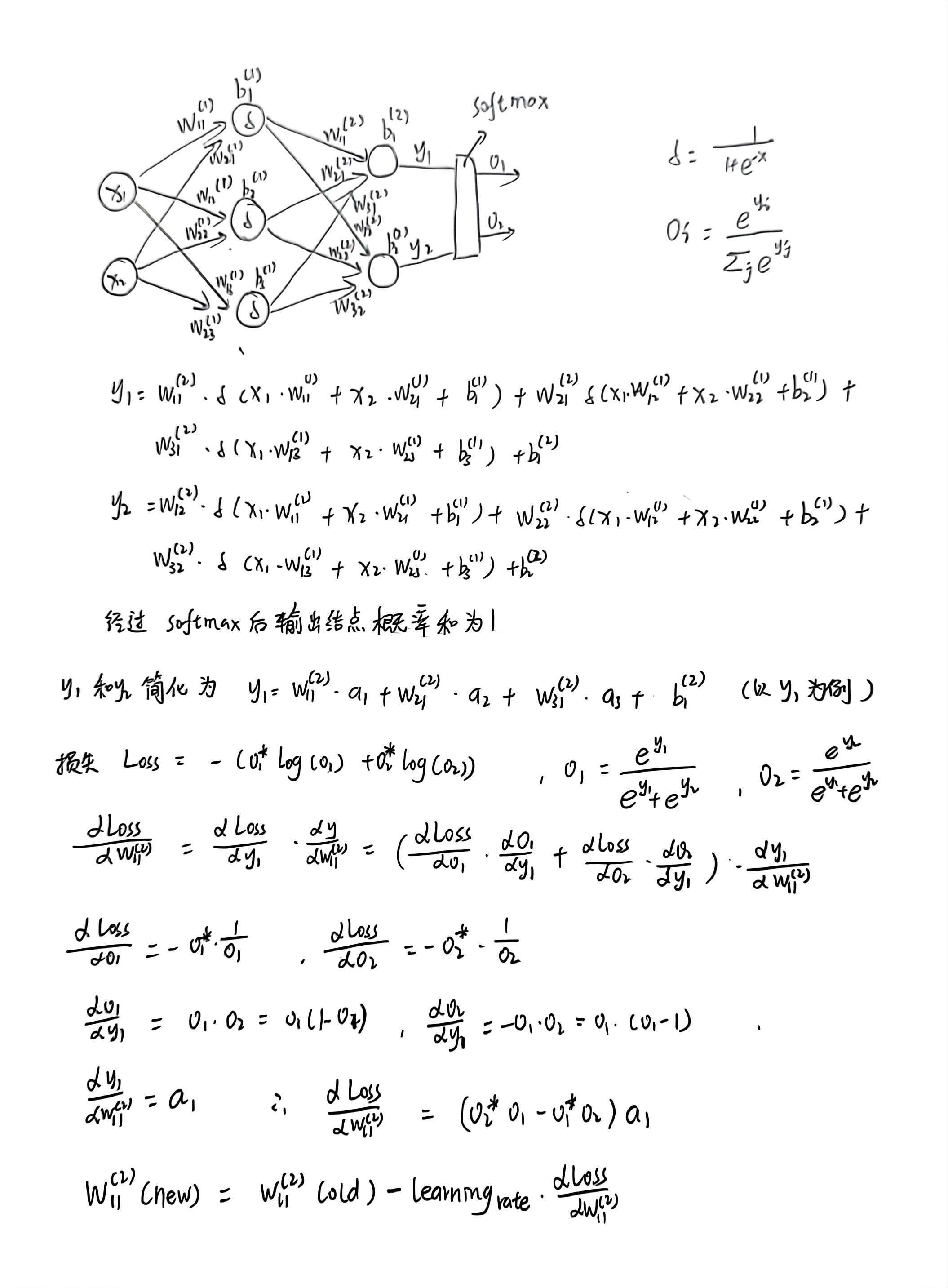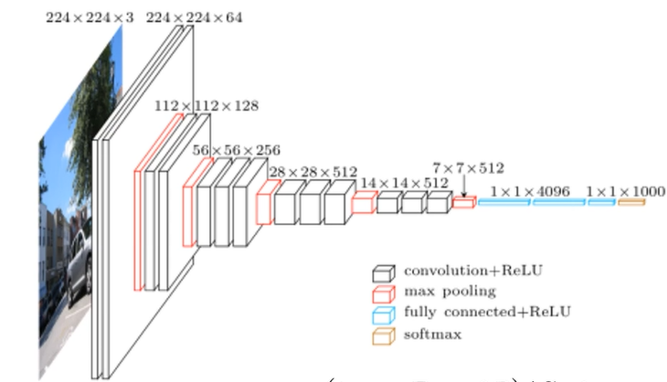深度理解卷积神经网络
| 阿里云国内75折 回扣 微信号:monov8 |
| 阿里云国际,腾讯云国际,低至75折。AWS 93折 免费开户实名账号 代冲值 优惠多多 微信号:monov8 飞机:@monov6 |
神经网络包括卷积层池化层全连接层。一个最简单的神经元结构假如有三个输入都对应一个权重参数然后通过权重加起来经过一个激活函数最后输出y。
CNN中独特的结构就是卷积层就是一个卷积核然后根据步幅进行扫描运算最后输出特征矩阵。卷积核的深度和输入特征矩阵的深度相同而输出的特征矩阵深度和卷积核个数相同。如果加上偏移量bias的话就在输出的特征矩阵进行相加减即可。
使用激活函数的目的是引用非线性因素具备解决非线性的能力。主要有sigmoid激活函数和Relu激活函数。sigmoid激活函数饱和时梯度值非常小当网络层较深时容易出现梯度消失。Relu激活函数当反向传播过程中有一个非常大的梯度经过时反向传播更新后可能导致权重分布中心小于零该处的导数始终为零反向传播无法更新权重进入失活状态。
卷积后的矩阵大小计算公式为

W代表图片大小F是卷积核的大小P是填充的像素数。S是步长。当卷积的时候越界的时候可以用padding进行补0处理
池化层我理解的就是个缩小矩阵将特征图进行稀疏处理减少运算量。可以进行取最大值池化也可以取平均值池化。经过池化层不改变深度只改变高度和宽度一般来说poolsize和stride相同。
然后对于误差的计算真是一个复杂的过程还好计算机会帮我们计算的推理过程比较麻烦。。。
反向传播的时候有一个交叉熵损失函数对于多分类问题softmax输出所有的输出概率和为1损失计算公式

对于二分类问题sigmoid输出每个输出结点之间互不相干计算公式如下

Oi*是真实标签值Oi为预测值。
反向传播的过程中权重会不断地更新分批次进行求解通常还需要一个优化器比如SGDAdam等这些直接调用即可使用优化器的目的就是使得网络更快的收敛。
为了深度理解反向传播过程再完整推导一遍

LeNet
LeNet基本结构就是一个5*5卷积层padding为2然后是2*2的池化层步幅为2再接一个5*5卷积层再接一个2*2的池化层步幅为2最后是三个全连接层。
import torch.nn as nn
import torch.nn.functional as F
# 定义类初始化函数继承于nn.Module
class LeNet(nn.Module):
def __init__(self):
# 解决调用父类函数时可能出现的一系列问题
super(LeNet, self).__init__()
# 定义卷积层
# 第一个参数是输入特征层的深度16个卷积核卷积核尺寸为5*5
self.conv1 = nn.Conv2d(3, 16, 5)
# 池化层,池化核的大小2*2步幅为2
self.pool1 = nn.MaxPool2d(2, 2)
# 上一层是卷积核为16所以输入深度应该是16。32个卷积核卷积核尺寸为5*5
self.conv2 = nn.Conv2d(16, 32, 5)
# 池化层
self.pool2 = nn.MaxPool2d(2, 2)
# 三层全连接层
# 全连接层需要把特征矩阵展平32 * 5 * 5就是展平操作120是全连接层的结点个数
self.fc1 = nn.Linear(32 * 5 * 5, 120)
self.fc2 = nn.Linear(120, 84)
# 最后一层设置为10根据训练集的类别个数来定义
self.fc3 = nn.Linear(84, 10)
# 正向传播过程
def forward(self, x):
# 经过卷积之后的矩阵尺寸大小计算公式N=(W-F+2P)/S+1,输入图片大小W*WF是卷积核的大小padding的像素数ps是步长
# 假如传入第一个卷积层input(3, 32, 32) output(16, 28, 28)输出深度为16卷积后的矩阵大小为32*32
x = F.relu(self.conv1(x))
# 深度不变高度宽度改变为原来的一半
# output(16, 14, 14)
x = self.pool1(x)
# relu激活函数
x = F.relu(self.conv2(x)) # output(32, 10, 10)
x = self.pool2(x) # output(32, 5, 5)
# view代表展成一维向量-1是第一个维度是自动推理的
x = x.view(-1, 32 * 5 * 5) # output(32*5*5)
x = F.relu(self.fc1(x)) # output(120)
x = F.relu(self.fc2(x)) # output(84)
# 全连接层3没用激活函数理论应该接一个激活函数但是在计算交叉熵损失函数时实现了一个softmax方法这里就不用定义了
x = self.fc3(x) # output(10)
return x
import torch
# batch为32深度为3高度32宽度32
input = torch.rand([32, 3, 32, 32])
# 实例化模型
model = LeNet()
# 打印模型
print(model)
# 前向传播
output = model(input)
# nn.Conv2d
# def __init__(
# self,
# in_channels: int,//深度
# out_channels: int,//代表卷积核的个数使用几个卷积核生成深度多少维的特征矩阵
# kernel_size: _size_2_t,//代表卷积核的大小
# stride: _size_2_t = 1,//步距
# padding: Union[str, _size_2_t] = 0,//四周补零处理
# dilation: _size_2_t = 1,
# groups: int = 1,
# bias: bool = True,//偏置默认是使用的
# padding_mode: str = 'zeros', # TODO: refine this type
# device=None,
# dtype=None
# ) -> None:
# MaxPool2d
# def __init__(
# self,
# in_channels: int,
# out_channels: int,
# kernel_size: _size_2_t,池化核的大小
# stride: _size_2_t = 1,步距
# padding: Union[str, _size_2_t] = 0,
# dilation: _size_2_t = 1,
# groups: int = 1,
# bias: bool = True,
# padding_mode: str = 'zeros', # TODO: refine this type
# device=None,
# dtype=None
# ) -> None:
AlexNet
AlexNet网络的结构还是有一点点复杂的先是11*11的卷积层步幅为4然后3*3的池化层卷积层池化层然后又接着3个卷积层再接一个池化层最后是三个全连接层。
AlexNet网络的优点在于使用了ReLU激活函数而不是传统的Sigmoid激活函数以及Tanh激活函数在全连接层的前两层中使用了Dropout进行随机失活神经元减少过拟合就是在正向传播的时候随机失活一部分神经元。
过拟合的原因往往是特征维度过多模型假设过于复杂参数多训练数据少噪声过多过度的拟合了训练数据而没有考虑泛化能力。
还有就是预测的时候记得别把图片路径写错就行了写绝对路径记得写\\不要写成\这样怎么样都不会出错。
import torch.nn as nn
import torch
class AlexNet(nn.Module):
def __init__(self, num_classes=1000, init_weights=False):
super(AlexNet, self).__init__()
# 网络多时可以定义nn.Sequential
self.features = nn.Sequential( # 将一系列的层结构打包
nn.Conv2d(3, 48, kernel_size=11, stride=4, padding=2), # input[3, 224, 224] output[48, 55, 55]
nn.ReLU(inplace=True), # 代表载入更大的模型
nn.MaxPool2d(kernel_size=3, stride=2), # output[48, 27, 27]
nn.Conv2d(48, 128, kernel_size=5, padding=2), # output[128, 27, 27]
nn.ReLU(inplace=True),
nn.MaxPool2d(kernel_size=3, stride=2), # output[128, 13, 13]
nn.Conv2d(128, 192, kernel_size=3, padding=1), # output[192, 13, 13]
nn.ReLU(inplace=True),
nn.Conv2d(192, 192, kernel_size=3, padding=1), # output[192, 13, 13]
nn.ReLU(inplace=True),
nn.Conv2d(192, 128, kernel_size=3, padding=1), # output[128, 13, 13]
nn.ReLU(inplace=True),
nn.MaxPool2d(kernel_size=3, stride=2), # output[128, 6, 6]
)
self.classifier = nn.Sequential(
nn.Dropout(p=0.5), # p随机失活的比例
nn.Linear(128 * 6 * 6, 2048),
nn.ReLU(inplace=True),
nn.Dropout(p=0.5),
nn.Linear(2048, 2048), # 第一个2048是上一层的输出第二个是这一层的结点个数
nn.ReLU(inplace=True),
nn.Linear(2048, num_classes), # num_classes输出是数据集类别的个数
)
if init_weights:
self._initialize_weights()
def forward(self, x):
x = self.features(x)
x = torch.flatten(x, start_dim=1) # 展平
x = self.classifier(x) # 传入全连接层
return x
def _initialize_weights(self):
for m in self.modules(): # 迭代每一层结构
if isinstance(m, nn.Conv2d):
nn.init.kaiming_normal_(m.weight, mode='fan_out', nonlinearity='relu')
if m.bias is not None:
nn.init.constant_(m.bias, 0)
elif isinstance(m, nn.Linear):
nn.init.normal_(m.weight, 0, 0.01)
nn.init.constant_(m.bias, 0)
VGG
VGG网络算是一个替代的思想吧比如可以堆叠两个3*3的卷积核替代5*5的卷积核堆叠三个3*3的卷积核替代7*7的卷积核也可以减少参数量。
以VGG-16为例先是2个卷积层每个有64个卷积核再接池化层然后接2个卷积层128个卷积核池化层3个卷积层256个卷积核池化层三个卷积层512个卷积核池化层然后3个卷积层512个卷积核再接池化层最后三个全连接层。这个网络还是比较大的用GPU跑也得好久。

import torch.nn as nn
import torch
class VGG(nn.Module):
def __init__(self, features, num_classes=1000, init_weights=False):
super(VGG, self).__init__()
self.features = features
self.classifier = nn.Sequential(
nn.Linear(512 * 7 * 7, 4096),
nn.ReLU(True),
nn.Dropout(p=0.5), # 随机失活
nn.Linear(4096, 4096),
nn.ReLU(True),
nn.Dropout(p=0.5),
nn.Linear(4096, num_classes)
)
if init_weights:
self._initialize_weights()
def forward(self, x):
# N x 3 x 224 x 224
x = self.features(x)
# N x 512 x 7 x 7
x = torch.flatten(x, start_dim=1) # 展平处理
# N x 512*7*7
x = self.classifier(x)
return x
def _initialize_weights(self):
for m in self.modules():
if isinstance(m, nn.Conv2d):
# nn.init.kaiming_normal_(m.weight, mode='fan_out', nonlinearity='relu')
nn.init.xavier_uniform_(m.weight)
if m.bias is not None:
nn.init.constant_(m.bias, 0)
elif isinstance(m, nn.Linear):
nn.init.xavier_uniform_(m.weight)
# nn.init.normal_(m.weight, 0, 0.01)
nn.init.constant_(m.bias, 0)
# make_features生成提取特征网络结构
def make_features(cfg: list): # 配置列表
layers = [] # 存放创建的每一层结构
in_channels = 3 # 输入的是RGB彩色通道所以是3
for v in cfg:
if v == "M": # 说明是池化层
layers += [nn.MaxPool2d(kernel_size=2, stride=2)]
else:
conv2d = nn.Conv2d(in_channels, v, kernel_size=3, padding=1)
layers += [conv2d, nn.ReLU(True)]
in_channels = v
return nn.Sequential(*layers)
def vgg(model_name="vgg16", **kwargs):
assert model_name in cfgs, "Warning: model number {} not in cfgs dict!".format(model_name)
cfg = cfgs[model_name]
model = VGG(make_features(cfg), **kwargs)
return model
GoogLeNet
GoogLeNet网络的优点在于引入了Inception结构使用1*1的卷积核进行降维以及映射处理而且添加了两个辅助分类器帮助训练丢弃了全连接层使用平均池化层GoogLeNet有三个输出层。
import torch.nn as nn
import torch
import torch.nn.functional as F
class GoogLeNet(nn.Module):
def __init__(self, num_classes=1000, aux_logits=True, init_weights=False):
super(GoogLeNet, self).__init__()
self.aux_logits = aux_logits
self.conv1 = BasicConv2d(3, 64, kernel_size=7, stride=2, padding=3)
self.maxpool1 = nn.MaxPool2d(3, stride=2, ceil_mode=True)
self.conv2 = BasicConv2d(64, 64, kernel_size=1)
self.conv3 = BasicConv2d(64, 192, kernel_size=3, padding=1)
self.maxpool2 = nn.MaxPool2d(3, stride=2, ceil_mode=True)
self.inception3a = Inception(192, 64, 96, 128, 16, 32, 32)
self.inception3b = Inception(256, 128, 128, 192, 32, 96, 64)
self.maxpool3 = nn.MaxPool2d(3, stride=2, ceil_mode=True)
self.inception4a = Inception(480, 192, 96, 208, 16, 48, 64)
self.inception4b = Inception(512, 160, 112, 224, 24, 64, 64)
self.inception4c = Inception(512, 128, 128, 256, 24, 64, 64)
self.inception4d = Inception(512, 112, 144, 288, 32, 64, 64)
self.inception4e = Inception(528, 256, 160, 320, 32, 128, 128)
self.maxpool4 = nn.MaxPool2d(3, stride=2, ceil_mode=True)
self.inception5a = Inception(832, 256, 160, 320, 32, 128, 128)
self.inception5b = Inception(832, 384, 192, 384, 48, 128, 128)
if self.aux_logits:
self.aux1 = InceptionAux(512, num_classes)
self.aux2 = InceptionAux(528, num_classes)
self.avgpool = nn.AdaptiveAvgPool2d((1, 1))
self.dropout = nn.Dropout(0.4)
self.fc = nn.Linear(1024, num_classes)
if init_weights:
self._initialize_weights()
def forward(self, x):
# N x 3 x 224 x 224
x = self.conv1(x)
# N x 64 x 112 x 112
x = self.maxpool1(x)
# N x 64 x 56 x 56
x = self.conv2(x)
# N x 64 x 56 x 56
x = self.conv3(x)
# N x 192 x 56 x 56
x = self.maxpool2(x)
# N x 192 x 28 x 28
x = self.inception3a(x)
# N x 256 x 28 x 28
x = self.inception3b(x)
# N x 480 x 28 x 28
x = self.maxpool3(x)
# N x 480 x 14 x 14
x = self.inception4a(x)
# N x 512 x 14 x 14
if self.training and self.aux_logits: # eval model lose this layer
aux1 = self.aux1(x)
x = self.inception4b(x)
# N x 512 x 14 x 14
x = self.inception4c(x)
# N x 512 x 14 x 14
x = self.inception4d(x)
# N x 528 x 14 x 14
if self.training and self.aux_logits: # eval model lose this layer
aux2 = self.aux2(x)
x = self.inception4e(x)
# N x 832 x 14 x 14
x = self.maxpool4(x)
# N x 832 x 7 x 7
x = self.inception5a(x)
# N x 832 x 7 x 7
x = self.inception5b(x)
# N x 1024 x 7 x 7
x = self.avgpool(x)
# N x 1024 x 1 x 1
x = torch.flatten(x, 1)
# N x 1024
x = self.dropout(x)
x = self.fc(x)
# N x 1000 (num_classes)
if self.training and self.aux_logits: # eval model lose this layer
return x, aux2, aux1
return x
def _initialize_weights(self):
for m in self.modules():
if isinstance(m, nn.Conv2d):
nn.init.kaiming_normal_(m.weight, mode='fan_out', nonlinearity='relu')
if m.bias is not None:
nn.init.constant_(m.bias, 0)
elif isinstance(m, nn.Linear):
nn.init.normal_(m.weight, 0, 0.01)
nn.init.constant_(m.bias, 0)
class Inception(nn.Module):
def __init__(self, in_channels, ch1x1, ch3x3red, ch3x3, ch5x5red, ch5x5, pool_proj):
super(Inception, self).__init__()
self.branch1 = BasicConv2d(in_channels, ch1x1, kernel_size=1)
self.branch2 = nn.Sequential(
BasicConv2d(in_channels, ch3x3red, kernel_size=1),
BasicConv2d(ch3x3red, ch3x3, kernel_size=3, padding=1) # 保证输出大小等于输入大小
)
self.branch3 = nn.Sequential(
BasicConv2d(in_channels, ch5x5red, kernel_size=1),
# 在官方的实现中其实是3x3的kernel并不是5x5这里我也懒得改了具体可以参考下面的issue
# Please see https://github.com/pytorch/vision/issues/906 for details.
BasicConv2d(ch5x5red, ch5x5, kernel_size=5, padding=2) # 保证输出大小等于输入大小
)
self.branch4 = nn.Sequential(
nn.MaxPool2d(kernel_size=3, stride=1, padding=1),
BasicConv2d(in_channels, pool_proj, kernel_size=1)
)
def forward(self, x):
branch1 = self.branch1(x)
branch2 = self.branch2(x)
branch3 = self.branch3(x)
branch4 = self.branch4(x)
outputs = [branch1, branch2, branch3, branch4]
return torch.cat(outputs, 1)
class InceptionAux(nn.Module):
def __init__(self, in_channels, num_classes):
super(InceptionAux, self).__init__()
self.averagePool = nn.AvgPool2d(kernel_size=5, stride=3)
self.conv = BasicConv2d(in_channels, 128, kernel_size=1) # output[batch, 128, 4, 4]
self.fc1 = nn.Linear(2048, 1024)
self.fc2 = nn.Linear(1024, num_classes)
def forward(self, x):
# aux1: N x 512 x 14 x 14, aux2: N x 528 x 14 x 14
x = self.averagePool(x)
# aux1: N x 512 x 4 x 4, aux2: N x 528 x 4 x 4
x = self.conv(x)
# N x 128 x 4 x 4
x = torch.flatten(x, 1)
x = F.dropout(x, 0.5, training=self.training)
# N x 2048
x = F.relu(self.fc1(x), inplace=True)
x = F.dropout(x, 0.5, training=self.training)
# N x 1024
x = self.fc2(x)
# N x num_classes
return x
class BasicConv2d(nn.Module):
def __init__(self, in_channels, out_channels, **kwargs):
super(BasicConv2d, self).__init__()
self.conv = nn.Conv2d(in_channels, out_channels, **kwargs)
self.relu = nn.ReLU(inplace=True)
def forward(self, x):
x = self.conv(x)
x = self.relu(x)
return x
ResNet
到目前为止我觉得这个网络是所有网络中最厉害的一个迭代一次精度就到了90%多最高94%左右也可以利用迁移学习加速进行训练。
首先它的网络结构可以突破一百层运用了残差块的思想丢弃dropout使用Batch Normalization加速训练。
18层和34层的结构在conv2_x这一层没有经过一个1*1的卷积层通常使用实线直接标注后面层的第一个残差块都是用了一个1*1的卷积核得到我们想要的维数。
50层101层以及152层的结构第一个残差块都是用了一个1*1的卷积核注意的是conv2_x这一层对应的1*1卷积层只改变了深度高宽没变接下来的几层不仅深度改变高度宽度都改变。
运用迁移学习可以快速的训练出一个理想的结果当数据集较小时也能训练出理想的结果。常见的迁移学习方式有载入权重后训练所有参数或者载入权重后只训练最后几层参数还有就是载入权重后在原网络基础上再添加一层全连接层仅训练一个全连接层。
还有一个ResNeXt网络这个网络是对ResNet的一个改进但是训练的时候我感觉好像有点。。。基本是一个groups分组的思想能减少一部分参数降低错误率。
import torch.nn as nn
import torch
# 18层34层
class BasicBlock(nn.Module):
expansion = 1
def __init__(self, in_channel, out_channel, stride=1, downsample=None, **kwargs):
super(BasicBlock, self).__init__()
self.conv1 = nn.Conv2d(in_channels=in_channel, out_channels=out_channel,
kernel_size=3, stride=stride, padding=1, bias=False)
self.bn1 = nn.BatchNorm2d(out_channel)
self.relu = nn.ReLU()
self.conv2 = nn.Conv2d(in_channels=out_channel, out_channels=out_channel,
kernel_size=3, stride=1, padding=1, bias=False)
self.bn2 = nn.BatchNorm2d(out_channel)
self.downsample = downsample
def forward(self, x):
identity = x
if self.downsample is not None:
identity = self.downsample(x)
out = self.conv1(x)
out = self.bn1(out)
out = self.relu(out)
out = self.conv2(out)
out = self.bn2(out)
out += identity
out = self.relu(out)
return out
class ResNet(nn.Module):
def __init__(self,
block,
blocks_num,
num_classes=1000,
include_top=True,
groups=1,
width_per_group=64):
super(ResNet, self).__init__()
self.include_top = include_top
self.in_channel = 64
self.groups = groups
self.width_per_group = width_per_group
self.conv1 = nn.Conv2d(3, self.in_channel, kernel_size=7, stride=2,
padding=3, bias=False)
self.bn1 = nn.BatchNorm2d(self.in_channel)
self.relu = nn.ReLU(inplace=True)
self.maxpool = nn.MaxPool2d(kernel_size=3, stride=2, padding=1)
self.layer1 = self._make_layer(block, 64, blocks_num[0])
self.layer2 = self._make_layer(block, 128, blocks_num[1], stride=2)
self.layer3 = self._make_layer(block, 256, blocks_num[2], stride=2)
self.layer4 = self._make_layer(block, 512, blocks_num[3], stride=2)
if self.include_top:
self.avgpool = nn.AdaptiveAvgPool2d((1, 1)) # output size = (1, 1)
self.fc = nn.Linear(512 * block.expansion, num_classes)
for m in self.modules():
if isinstance(m, nn.Conv2d):
nn.init.kaiming_normal_(m.weight, mode='fan_out', nonlinearity='relu')
def _make_layer(self, block, channel, block_num, stride=1):
downsample = None
if stride != 1 or self.in_channel != channel * block.expansion:
downsample = nn.Sequential(
nn.Conv2d(self.in_channel, channel * block.expansion, kernel_size=1, stride=stride, bias=False),
nn.BatchNorm2d(channel * block.expansion))
layers = []
layers.append(block(self.in_channel,
channel,
downsample=downsample,
stride=stride,
groups=self.groups,
width_per_group=self.width_per_group))
self.in_channel = channel * block.expansion
for _ in range(1, block_num):
layers.append(block(self.in_channel,
channel,
groups=self.groups,
width_per_group=self.width_per_group))
return nn.Sequential(*layers)
def forward(self, x):
x = self.conv1(x)
x = self.bn1(x)
x = self.relu(x)
x = self.maxpool(x)
x = self.layer1(x)
x = self.layer2(x)
x = self.layer3(x)
x = self.layer4(x)
if self.include_top:
x = self.avgpool(x)
x = torch.flatten(x, 1)
x = self.fc(x)
return x
# 3463代表残差结构的个数
def resnet34(num_classes=1000, include_top=True):
# https://download.pytorch.org/models/resnet34-333f7ec4.pth
return ResNet(BasicBlock, [3, 4, 6, 3], num_classes=num_classes, include_top=include_top)MobileNetV1、V2、V3
MobileNetV1网络的亮点主要是采用DW卷积增加超参数α和β这俩参数是人为设定的虽然准确率稍微减少了一点但是模型参数少了很多。
MobileNetV1网络采用了到残差结构准确率更高模型更小。MobileNetV3网络采用了更进一步的更新加入了注意力机制更新了激活函数等等。MobileNetV2实现如下。
from torch import nn
import torch
class ConvBNReLU(nn.Sequential):
def __init__(self, in_channel, out_channel, kernel_size=3, stride=1, groups=1):
padding = (kernel_size - 1) // 2
super(ConvBNReLU, self).__init__(
nn.Conv2d(in_channel, out_channel, kernel_size, stride, padding, groups=groups, bias=False),
nn.BatchNorm2d(out_channel),
nn.ReLU6(inplace=True)
)
class InvertedResidual(nn.Module):
def __init__(self, in_channel, out_channel, stride, expand_ratio):
super(InvertedResidual, self).__init__()
hidden_channel = in_channel * expand_ratio
self.use_shortcut = stride == 1 and in_channel == out_channel
layers = []
if expand_ratio != 1:
# 1x1 pointwise conv
layers.append(ConvBNReLU(in_channel, hidden_channel, kernel_size=1))
layers.extend([
# 3x3 depthwise conv
ConvBNReLU(hidden_channel, hidden_channel, stride=stride, groups=hidden_channel),
# 1x1 pointwise conv(linear)
nn.Conv2d(hidden_channel, out_channel, kernel_size=1, bias=False),
nn.BatchNorm2d(out_channel),
])
self.conv = nn.Sequential(*layers)
def forward(self, x):
if self.use_shortcut:
return x + self.conv(x)
else:
return self.conv(x)
class MobileNetV2(nn.Module):
def __init__(self, num_classes=1000, alpha=1.0, round_nearest=8):
super(MobileNetV2, self).__init__()
block = InvertedResidual
input_channel = _make_divisible(32 * alpha, round_nearest)
last_channel = _make_divisible(1280 * alpha, round_nearest)
inverted_residual_setting = [
# t, c, n, s
[1, 16, 1, 1],
[6, 24, 2, 2],
[6, 32, 3, 2],
[6, 64, 4, 2],
[6, 96, 3, 1],
[6, 160, 3, 2],
[6, 320, 1, 1],
]
features = []
# conv1 layer
features.append(ConvBNReLU(3, input_channel, stride=2))
# building inverted residual residual blockes
for t, c, n, s in inverted_residual_setting:
output_channel = _make_divisible(c * alpha, round_nearest)
for i in range(n):
stride = s if i == 0 else 1
features.append(block(input_channel, output_channel, stride, expand_ratio=t))
input_channel = output_channel
# building last several layers
features.append(ConvBNReLU(input_channel, last_channel, 1))
# combine feature layers
self.features = nn.Sequential(*features)
# building classifier
self.avgpool = nn.AdaptiveAvgPool2d((1, 1))
self.classifier = nn.Sequential(
nn.Dropout(0.2),
nn.Linear(last_channel, num_classes)
)
# weight initialization
for m in self.modules():
if isinstance(m, nn.Conv2d):
nn.init.kaiming_normal_(m.weight, mode='fan_out')
if m.bias is not None:
nn.init.zeros_(m.bias)
elif isinstance(m, nn.BatchNorm2d):
nn.init.ones_(m.weight)
nn.init.zeros_(m.bias)
elif isinstance(m, nn.Linear):
nn.init.normal_(m.weight, 0, 0.01)
nn.init.zeros_(m.bias)
def forward(self, x):
x = self.features(x)
x = self.avgpool(x)
x = torch.flatten(x, 1)
x = self.classifier(x)
return x卷积神经网络算是正式完结了争取下周把目标检测也尽快弄清楚hhh。

